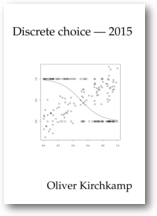Discrete Choice
- Lecture
- t.b.a.
- Audience
- The lecture is targeted at graduate students and at advanced students from the master program.
- Requirements:
- Econometrics I or MW 24.1 - Empirical Methods
- Exam
- t.b.a.
First part: Non-linear models (8.4.-20.5.)
- Topics
-
- Maximum Likelihood
- Nonlinear Regressions
- Discrete-Choice-Models (Murray 19; Greene 23)
- Count Data (Greene 25)
- Survival Models (Greene 24)
- Handout
- If you want to prepare for the lecture (or revise), you can have a look at the Handout. You will find still a lot of mistakes but you might get the idea ;-)
- Exercises
- ... can also be found in the appendix of the handout. Participants can solve the exercises in pairs and hand in the solutions (as text or pdf) before the next lecture. No pair can hand in more than two solutions. To get a credit for the course solutions to all exercises have to be submitted in time.
- Literature:
-
- William Greene, Econometric Analysis, Prentice Hall, 7th Edition, 2011.
- Michael Murray; Econometrics, a Modern Introduction; Pearson 2006
- Christian Gourieroux and Alain Monfort, Statistics and Econometric Models, Vol. 1, Cambridge, 1995.
- John K. Kruschke , Doing Bayesian Data Analysis: A Tutorial with R, JAGS, and Stan. Academic Press, 2nd Edition, 2014.
- Software
- For our practical examples (during the entire course) we will use the software environment R. I think that it is helpful to coordinate on one environment. R is free, it is very powerful, and it is popular in the field.
- Documentation for R is provided throught the built in help. You also find support on the R Homepage.
You might find the following useful:
- The R Guide, Jason Owen (Easy to read, explains R with the help of examples from basic statistics)
- Simple R, John Verzani (Explains R with the help of examples from basic statistics)
- Einführung in R, Günther Sawitzki (In German. Rather compact introduction.)
- Econometrics in R, Grant V. Farnsworth (The introduction to R is rather compact and pragmatic.)
- An Introduction to R, W. N. Venables und D. M. Smith (The focus is more on R as a programming language)
- The R language definition (Concentrates only on R as a programming language.)
- On the JAGS Homepage you go to the files pages, then to Manuals, to find the JAGS user manual.
- You can download R from the homepage of the R-project.
- Installing R with Microsoft Windows:
- Download and start the Installer. Install R on your local drive. Installing on a network drive or in the cloud (Dropbox, Onedrive,...) is possible but not recommended.
- Installing R with GNU-Linux:
- Follow the advice to install R for your distribution.
- Installing R with MacOS X:
- Here is a guide to install R with MacOS X.
- In the lecture we use RStudio as a front end.
- For the Bayesian parts we will use JAGS. It helps if you have installed R, RStudio, and JAGS on your computer when we start the course.
- We will use the following packages:
boot, car, Ecdat, ellipse, foreign, geepack, Hmisc, lattice, latticeExtra, lme4, lmtest, MASS, nlme, nnet, SASmixed, survival.If, e.g., the command
library(Ecdat)generates an error message (Error in library(Ecdat): There is no package called 'Ecdat'), you have to install the package.- Installing packages with Microsoft Windows:
- With RStudio: Use the tab “Install”. Otherwise: Start
Rgui.exeand install packages from the menuPackages / Install Packages). - Installing packages from GNU-Linux or MacOS X:
- From within R use the command
install.packages("Ecdat"), e.g., to install the packageEcdat
- Documentation for R is provided throught the built in help. You also find support on the R Homepage.
You might find the following useful:
